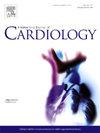A hybrid machine learning approach using particle swarm optimization for cardiac arrhythmia classification
IF 3.2
2区 医学
Q2 CARDIAC & CARDIOVASCULAR SYSTEMS
引用次数: 0
Abstract
Background
Precise and rapid identification of cardiac arrhythmias is paramount for delivering optimal patient care. Machine learning (ML) techniques hold significant promise for classifying arrhythmias, yet achieving peak performance often necessitates refined hyperparameter tuning.
Methods
This investigation presents a novel, multi-faceted strategy for cardiac arrhythmia classification, employing a synergistic model that combines Particle Swarm Optimization (PSO) with a range of ML algorithms, i.e., Logistic Regression, Linear Discriminant Analysis, Gaussian Naive Bayes, Decision Tree, and XGBoost Classifier to enhance their predictive capabilities. The models are implemented on the UCI cardiac arrhythmia dataset and validated by Stratify K-Fold.
Results
The hybrid models developed in this study exhibited a marked improvement over their unoptimized counterparts, demonstrating superior overall performance across a spectrum of metrics. Notably, Model 5, integrating PSO with the XGBoost Classifier, achieved exceptional results, including a 95.24 % accuracy, 94.81 % balanced accuracy, 96.3 % sensitivity, 93.3 % specificity, 96.3 % precision, 96.3 % F1 Score, 93.33 % NPV, 89.63 % MCC, 4.76 % CE, 14.44 LR+, 0.04 LR-, and a DOR of 364, surpassing the performance of previously reported methods. Furthermore, the models exhibited low computational cost and complexity, making them feasible for real-time applications.
Conclusions
This research underscores the effectiveness of PSO-optimized hybrid models for the accurate and efficient classification of cardiac arrhythmias. The proposed approach demonstrates a significant advancement over existing methodologies in terms of diagnostic performance, presenting a valuable resource for clinical decision-making. Future studies could explore the application of these models to diverse clinical problems and investigate their interpretability to enhance trust and adoption.

基于粒子群优化的混合机器学习方法在心律失常分类中的应用
背景:准确、快速地识别心律失常对于提供最佳的患者护理至关重要。机器学习(ML)技术在心律失常分类方面具有重要的前景,但实现峰值性能通常需要精细的超参数调整。方法本研究提出了一种新的、多方面的心律失常分类策略,采用协同模型,将粒子群优化(PSO)与一系列ML算法(即逻辑回归、线性判别分析、高斯朴素贝叶斯、决策树和XGBoost分类器)相结合,以增强其预测能力。该模型在UCI心律失常数据集上实现,并通过Stratify K-Fold进行验证。结果本研究中开发的混合模型比未优化的模型有明显的改进,在一系列指标中表现出卓越的整体性能。值得注意的是,将PSO与XGBoost Classifier集成的模型5取得了出色的结果,包括95.24%的准确率,94.81%的平衡准确率,96.3%的灵敏度,93.3%的特异性,96.3%的精度,96.3%的F1 Score, 93.33%的NPV, 89.63%的MCC, 4.76%的CE, 14.44 LR+, 0.04 LR-, DOR为364,超过了先前报道的方法的性能。此外,该模型具有较低的计算成本和计算复杂度,可用于实时应用。结论基于pso优化的混合模型对心律失常进行准确、高效的分类是有效的。所提出的方法在诊断性能方面比现有方法有了显著的进步,为临床决策提供了宝贵的资源。未来的研究可以探索这些模型在不同临床问题中的应用,并研究它们的可解释性,以增强信任和采用。
本文章由计算机程序翻译,如有差异,请以英文原文为准。
求助全文
约1分钟内获得全文
求助全文
来源期刊

International journal of cardiology
医学-心血管系统
CiteScore
6.80
自引率
5.70%
发文量
758
审稿时长
44 days
期刊介绍:
The International Journal of Cardiology is devoted to cardiology in the broadest sense. Both basic research and clinical papers can be submitted. The journal serves the interest of both practicing clinicians and researchers.
In addition to original papers, we are launching a range of new manuscript types, including Consensus and Position Papers, Systematic Reviews, Meta-analyses, and Short communications. Case reports are no longer acceptable. Controversial techniques, issues on health policy and social medicine are discussed and serve as useful tools for encouraging debate.
 求助内容:
求助内容: 应助结果提醒方式:
应助结果提醒方式:


